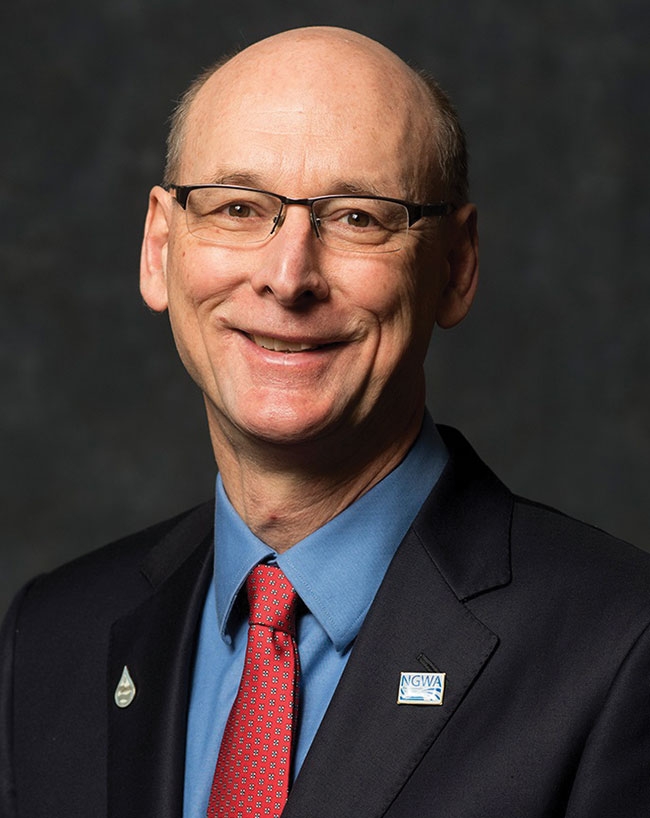
News
Working together: A conversation with Scott King
NGWA’s new president is on a mission to help all ground water professionals work as a team
May 1, 2019 By Colleen Cross
 NGWA board president Scott King is promoting the theme of “Better together” for all members of the association. “That’s a real opportunity for me as the first scientist to lead the board of directors,” King says. Photo courtesy William Ingalls
NGWA board president Scott King is promoting the theme of “Better together” for all members of the association. “That’s a real opportunity for me as the first scientist to lead the board of directors,” King says. Photo courtesy William IngallsScott King, PG, P.Geo., LHG, took the helm of the National Ground Water Association’s board of directors as president late in 2018.
We talked with the Canadian hydrogeologist from his home office in Buffalo, N.Y., about his professional experiences and his passion for getting water-well contractors, manufacturers, suppliers, scientists and engineers on the same page for the good of ground water.
GROUND WATER CANADA: WHAT IS THE SIGNIFICANCE OF YOUR ELECTION AS THE FIRST NGWA PRESIDENT FROM THE SCIENCE SECTOR?
SCOTT KING: Being elected president is a great honour for me and electing a scientist is a good thing for the association. It’s a signal that our association is going to look for the best leaders from different sections of our industry to work with the board of directors and move us forward. We all have something to contribute. At NGWA we’re trying to create a community of ground water professionals. “Better together” has been our theme for many years now and I want to continue with that.
WHAT SPARKED YOUR INTEREST IN GROUND WATER?
It goes back to when I was a student in earth sciences and geology at the University of Waterloo. I was looking for a course to take in the final year of my undergraduate degree. Someone suggested hydrogeology. I didn’t really know what that was. Turns out it was being taught by John Cherry, who is a tremendous professor and one of the most well-known ground water people in Canada, perhaps the world. He is just such a great teacher and the material was so stimulating and that really got me interested
This was in the early 1980s and at that time there were lots of stories about contamination of ground water in the news, such as Love Canal – not far from where I live now – so the whole concept of contaminant hydrogeology and material contaminants moving through ground water and affecting people’s wells was just fascinating to me. I’m really happy I took that elective. It wasn’t on my radar at all but it changed my life. Being in the earth sciences program, I had been more focused on structural geology and the chemistry of rocks and big-Earth picture things rather than movement of water.
ON WHAT AREAS OF GROUND WATER SCIENCE HAS MOST OF YOUR WORK focused?
After graduating from university, I worked with a consulting company, Golder Associates, with offices in Mississauga, Vancouver and Waterloo, and I worked there for 10 years. I started out in Toronto. Most of my time was spent doing ground water investigations around the Keele Valley landfill north of Toronto, which at that time was Canada’s largest landfill. They were building a liner to prevent leachates landfill from getting into the ground water. I was involved in developing monitoring programs for that and assessing how well the liner was working. I spent a lot of time working around landfills, uranium mining tailings in northern Ontario and other industrial properties in southern Ontario. I spent a couple of years working in Vancouver on the remediation of the former Expo 86 site, which was former industrial land on the waterfront that we were turning into land where people want to live. That has great challenges from an environmental protection point of view – both soil and ground water contamination issues.
I spent 10 years living and working for my own consulting company, King Groundwater Science Inc., in Pullman, Wash. My wife, Richelle Allen-King, was a professor of hydrogeology at Washington State University. This is in eastern Washington, which is underlain by Columbia River basalt aquifers, and this was a completely new and different area of interest for me. I also worked in the Seattle area on contaminated site issues while living in Washington State.
In 2003 we moved to Buffalo, N.Y. and have been based in Buffalo since then. My wife is now a professor at the University of Buffalo. Richelle is a terrific ground water scientist in her own right. Her area of expertise is in the movement of organic contaminants in ground water. I’m very proud of her because she was also the 2003 Henry Darcy Distinguished Lecturer for NGWA.
I worked on my own as a consultant for six years doing various projects. Niagara County, near Buffalo, has had some historical legacy issues relating to nuclear waste that date back to the Second World War and the Manhattan Project. I worked on a community project to help members of that community understand and deal with some of the issues relating to this contamination.
For the last 10 years I’ve been working with Wood Environment & Infrastructure Solutions (formerly known as AMEC, then Amec Foster Wheeler) for their Calgary office primarily focused on ground water issues associated with oilsands development in northern Alberta and other ground water issues in western Canada. It was surprising to me that oilsands mining had such a strong need for ground water management and that was interesting to me because it fits into the energy-water nexus of issues. It’s been a real challenge: most of my career has been dealing with contaminant hydrogeology or environmental issues, but this work has been primarily involved with ground water aquifer hydraulics and ground water control around open pits and tailings facilities on a very large scale. I have been travelling between Calgary and Buffalo since starting with Wood in 2009.
We’ve been using wells to pump ground water and control migration of contaminated water away from tailings facilities. It’s environmental protection. It’s been a huge challenge and it’s something I really enjoy because it’s important for me to keep learning.
WHAT HAVE YOU LEARNED FROM WORKING WITH WATER-WELL CONTRACTORS?
I guess the big lesson I’ve learned from working with drilling contractors is that they usually know what they’re talking about. As a young person I was pretty confident that I knew what I was doing, but when it comes to putting a well in the ground, the people who deal with this every day are the people who know what they’re doing. Even though I know what I want to have accomplished, the way to get it done is through the contractor. And contractors, typically, are very professional, very knowledgeable and very interested in what they’re doing and in helping me as a scientist get the information I need. So I’ve been very impressed with the drillers I’ve worked with. We all need to have respect for the knowledge of the other person because we all bring something to the table to solve a problem with ground water. That took me years to figure out.
WHICH CONTAMINANTS DO YOU THINK ARE THE MOST PRESSING CONCERNS?
What’s right front and centre for people in the U.S. is perfluorinated compounds, or PFCs. A subset of those are called perfluorinated alkylated substances, also known as PFAS. These are compounds which are found throughout our society, often used in firefighting foams, Teflon materials, and other great products that we use throughout our lives. We’re finding these compounds have toxic properties at very, very low concentrations, and are very mobile in ground water. This is going to be our next challenge in terms of the contaminants that come our way to deal with. Over the years we’ve dealt with chlorinated compounds, such as solids, trichloroethylene. Another area of real concern is nitrate from fertilizers, which has been applied for the last 60 years and in some parts of North America we’re seeing lots of storage of nitrate compounds and salts, which are gradually working their way down into the ground water system. I think it’s going to be a long-term issue for many rural agricultural areas.
We’re looking carefully at PFAS issues and NGWA is taking steps to pull together information and educational materials for government as well as homeowners and contractors so that we can share knowledge about how to deal with these. It’s going to take the entire community of ground water professionals – from those who investigate and design clean-up methods to those who install wells and treatment systems – to solve these problems. It’s manufacturers, it’s suppliers, it’s scientists and engineers and it’s drilling contractors – they’re all going to have a role.
WHAT IS THE BIGGEST THREAT TO GROUND WATER?
I think the biggest threat to ground water is that people take it for granted. Ground water is such an important, cost-effective and clean source of drinking water for our society. The public needs to understand that it’s important to protect ground water quality in terms of not allowing contamination and it’s important to manage ground water pumping so we can maintain a sustainable supply of drinking water.
WHAT KINDS OF QUESTIONS DO YOU GET FROM NGWA MEMBERS?
I’ve visited a few state associations and, so far, what people are interested in are some of the educational and certification offerings that NGWA provides: very practical questions like “How do I take this test?” or “Can you help us get information?” That’s an area we’re focusing on by working with our affiliate state and provincial associations to help them get the information they need. We’re encouraging members to consider getting certified. Certification is an indication that they’ve met a certain standard as a contractor and can be a good marketing and distinguishing tool for them.
WHAT ARE SOME OF THE INITIATIVES NGWA HAS UNDERTAKEN RECENTLY?
I want to highlight a few wins we’ve had in our advocacy programs. In the last year, we’ve had tax credits restored for geothermal pumps, there has been brownfield legislation expanded, we’ve created a working document to help people understand PFAS and we’ve had some wins in terms of funding for investment in rural wells in small communities. Recently we’ve developed a water-well construction standard through ANSI, which is a great development and feather in the cap for NGWA and should benefit our members.
WHAT ARE YOUR GOALS AS PRESIDENT?
As president of the board of directors, our first duty is to take care of the business of our association. We have fiduciary responsibilities we need to look after to make sure our association can carry on and prosper.
And then, we need to provide value to members – otherwise, why would they want to be part of an association. I see part of that value is going to be advocacy within the political process for the benefit of various parts of our membership and the protection of ground water. I really want to continue with our “Better together” theme for all members of our association. For me, that’s a real opportunity for me as the first scientist to lead the board of directors.
We want to become the lead ground water resource for federal, state and local governments and regulatory agencies and be a source of information for contaminant problems such as PFAS and managed aquifer recharge, which we think is going to be a very important issue in the future. All that comes out of developing a comprehensive advocacy plan so we can advance the goals of the ground water community, in the United States and, where it applies, in other parts of the world.
WHAT IS A PROMISING AREA OF DEVELOPMENT FOR THE INDUSTRY?
Managed aquifer recharge, or MAR, is the process of taking excess water, primarily surface water, putting it back into the ground for storage and then being able to take it out when you need it. In North America, we often have excess water in the spring from snowmelt or rainfall. Once we’ve protected our needed base flow in streams, we can take some of that excess water and put it in the ground – at times when we’ve got lots of water – store it, then use it later in the year when we don’t have much rainfall. This can be a really cost-effective way to use aquifers as part of ground water infrastructure and maintain the sustainability and resilience of our water supply.
The strategy is already being used in some parts of Canada and the U.S. and could be enhanced in the future. To do this effectively, this is another area where all parts of our ground water community could be involved. One aspect is to drill appropriate wells for injection. Another is for scientists and engineers to design, manage and model how this might work. And then there are certain products we’re going to need – for example, pumps, piping and infrastructure – that our manufacturers could help with.
WOULD YOU CARE TO COMMENT ON THE FORMATION OF THE CANADIAN NATIONAL GROUND WATER ASSOCIATION?
I’m really pleased to see the formation of a new Canadian association and I’ll be happy to support it in whatever way I can. NGWA is also pleased to see an association move forward. NGWA’s mission is to create a community of ground water professionals and we’re working together to advance ground water knowledge and success for our members. I think one of the ways the Canadian ground water industry can do that is through a national association.
WHEN YOU’RE NOT STUDYING OR ADVOCATING FOR GROUND WATER, WHAT DO YOU LIKE TO DO?
I like to ski in the winter. Richelle and I enjoy cross-country skiing and we like to get outdoors and go hiking and camping. For the last few years since I’ve been working for the Calgary office, we’ve spent time in Banff, Jasper and Yoho national parks hiking.
The other hobby I have is woodworking. I’ve been trying my hand at making furniture and small pieces for the house as well as making repairs to our old house. It gets me out of my office and away from a computer monitor. It’s nice to do something different with your hands and your brain.
Editor’s note: This interview has been edited and condensed.
Print this page

